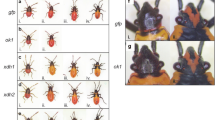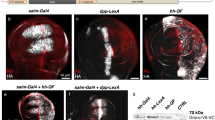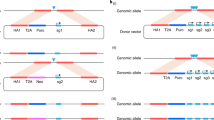Abstract
Many mutations at complex genetic loci in the f ruitfly Drosophila melanogaster are associated with insertions of transposable elements. At the Notch locus, members of one class of insertion-associated mutations, termed glossy-like, produce a recessive viable, smooth-eye phenotype with mottled pigmentation1. Members of a second class, facet, produce a recessive viable, rough-eye phenotype with homogeneous pigmentation1. Both classes of mutations fail to complement Notch lethal mutations, so they behave as Notch alleles1. Here we report that each glossy-like mutation is associated with an insertion of the same transposable element (flea). Each flea insertion occurs in the same orientation, but at different locations within intervening sequences of the Notch locus. In contrast, each facet mutation is associated with insertion of a unique, non-flea, transposable element. Insertions producing a facet phenotype and insertions causing a glossy-like phenotype can break Notch intervening sequences at precisely the same location. This suggests that the type of insertion element rather than its position within an affected gene is the primary determinant of the phenotype observed.
This is a preview of subscription content, access via your institution
Access options
Subscribe to this journal
Receive 51 print issues and online access
$199.00 per year
only $3.90 per issue
Buy this article
- Purchase on Springer Link
- Instant access to full article PDF
Prices may be subject to local taxes which are calculated during checkout
Similar content being viewed by others
References
Lindsley, D. L. & Zimm, G. Drosophila Information Service 62, 114–116 (1985).
Kidd, S., Lockett, T. J. & Young, M. W. Cell 34, 421–433 (1983).
Grimwade, B. G., Muskavitch, M. A. T., Welshons, W. J., Yedvobnick, B. & Artavanis-Tsakonas, S. Devl Biol. 107, 503–519 (1985).
Shellenbarger, D. L. & Mohler, J. D. Devl Biol. 62, 432–446 (1978).
Kidd, S., Kelley, M. R. & Young, M. W. Molec. Cell. Biol. 6, 3094–3108 (1986).
Welshons, W. J. Genetics 76, 775–794 (1974).
Karlik, C. C. & Fyrberg, E. A. Cell 41, 57–66 (1985).
Melton, D. A. et al. Nucleic Acids Res. 12, 7035–7056 (1984).
Norrander, J., Kempe, T. & Messing, J. Gene 26, 101–106 (1983).
Sanger, F., Coulson, A. R., Barrell, B. G., Smith, A. J. H. & Roe, B. A. J. molec. Biol. 143, 161–178 (1980).
Biggin, M. D., Gibson, T. J. & Hong, G. F. Proc. natn. Acad. Sci. U.S.A 80, 3963–3965 (1983).
Author information
Authors and Affiliations
Rights and permissions
About this article
Cite this article
Kidd, S., Young, M. Transposon-dependent mutant phenotypes at the Notch locus of Drosophila. Nature 323, 89–91 (1986). https://doi.org/10.1038/323089a0
Received:
Accepted:
Issue Date:
DOI: https://doi.org/10.1038/323089a0
This article is cited by
-
Notch signaling pathway: architecture, disease, and therapeutics
Signal Transduction and Targeted Therapy (2022)
-
Notch signaling coordinates ommatidial rotation in the Drosophila eye via transcriptional regulation of the EGF-Receptor ligand Argos
Scientific Reports (2019)
-
The Drosophila forked gene encodes two major RNAs, which, in gypsy or springer insertion mutants, are partially or completely truncated within the 5′-LTR of the inserted retrotransposon
Molecular and General Genetics MGG (1993)
-
Retrotransposons and the evolution of mammalian gene expression
Genetica (1992)
-
Effect of transvection on the expression of the Notch locus in Drosophila melanogaster
Heredity (1988)
Comments
By submitting a comment you agree to abide by our Terms and Community Guidelines. If you find something abusive or that does not comply with our terms or guidelines please flag it as inappropriate.



